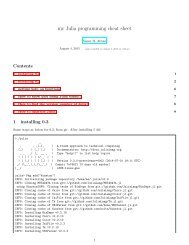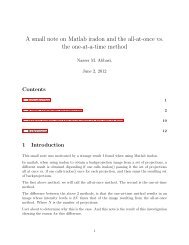Create successful ePaper yourself
Turn your PDF publications into a flip-book with our unique Google optimized e-Paper software.
x 1<br />
x 2<br />
k 1 x 1<br />
k 2 x 2 x 1 <br />
m<br />
k 2 x 2 x 1 <br />
m 2<br />
1<br />
f 1 t<br />
f 2 t<br />
F m 1 x 1<br />
<br />
k 1 x 1 k 2 x 2 x 1 f 1 t m 1 x 1<br />
<br />
F m 2 x 2<br />
<br />
k 2 x 2 x 1 f 2 t m 2 x 2<br />
<br />
Hence, from the above the equations of motion are<br />
or<br />
In Matrix form<br />
⎡ ⎤ ⎧<br />
⎣ m 1 0 ⎨<br />
⎦<br />
0 m<br />
⎩<br />
2<br />
m 1 x ′′<br />
1 + k 1 x 1 − k 2 (x 2 − x 1 ) = f 1 (t)<br />
m 2 x ′′<br />
2 + k 2 (x 2 − x 1 ) = f 2 (t)<br />
m 1 x ′′<br />
1 + x 1 (k 1 + k 2 ) − k 2 x 2 = f 1 (t)<br />
m 2 x ′′<br />
2 + k 2 x 2 − k 2 x 1 = f 2 (t)<br />
x ′′<br />
1<br />
x ′′<br />
2<br />
⎫ ⎡<br />
⎤ ⎧ ⎫ ⎧ ⎫<br />
⎬<br />
⎭ + ⎣ k 1 + k 2 −k 2<br />
⎨x ⎦ 1 ⎬ ⎨<br />
−k 2 k<br />
⎩<br />
2 x<br />
⎭ = f 1 (t) ⎬<br />
⎩<br />
2 f 2 (t)<br />
⎭<br />
The above two EOM are coupled in stiffness, but not mass coupled. Using short notations, the above is<br />
written as<br />
[M]{x ′′ } + [K]{x} = {f}<br />
Modal analysis now starts with the goal to decouple the EOM and obtain the fundamental shape functions that<br />
the system can vibrate in. To make these derivations more general, the mass matrix and the stiffness matrix are<br />
written in general notations as follows<br />
⎡ ⎤ ⎧<br />
⎣ m 11 m 12<br />
⎨<br />
⎦<br />
m 21 m<br />
⎩<br />
22<br />
x ′′<br />
1<br />
x ′′<br />
2<br />
⎫ ⎡ ⎤ ⎧ ⎫ ⎧ ⎫<br />
⎬<br />
⎭ + ⎣ k 11 k 12<br />
⎨x ⎦ 1 ⎬ ⎨<br />
k<br />
⎩<br />
22 x<br />
⎭ = f 1 (t) ⎬<br />
⎩<br />
2 f 2 (t)<br />
⎭<br />
k 21<br />
The mass matrix [M] and the stiffness matrix [K] must always come out to be symmetric. If they are not<br />
symmetric, then a mistake was made in obtaining them. As a general rule, the mass matrix [M] is PSD (positive<br />
definite matrix) and the [K] matrix is positive semi-definite matrix. The reason the [M] is PSD is that x T [M]{x}<br />
represents the kinetic energy of the system, which is typically positive and not zero. But reading some other<br />
references 1 it is possible that [M] can be positive semi-definite. It depends on the application being modeled.<br />
1.2 Step 2, solving the eigenvalue problem, finding the natural frequencies<br />
The first step in modal analysis is to solve the eigenvalue problem det ( [K] − ω 2 [M] ) = 0 in order to determine<br />
the natural frequencies of the system. This equations leads to a polynomial in ω and the roots of this polynomial<br />
1 http://en.wikipedia.org/wiki/Fundamental_equation_of_constrained_motion<br />
4





